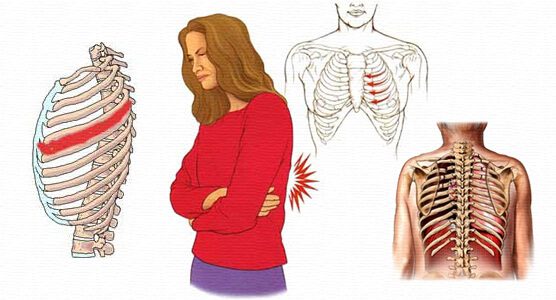Contents
Intercostal neuralgia
Intercostal neuralgia is chest pain in the area of the intercostal nerves. It is caused by the compression of one of the 24 nerves located between the ribs and the intercostal muscles, at the level of the rib cage.
Intercostal neuralgia, what is it?
Definition of intercostal neuralgia
Intercostal neuralgia is characterized by pain in the chest caused by inflammation or damage to an intercostal nerve, that is, a nerve that originates from a root in the spinal cord and is located between the ribs.
The causes of intercostal neuralgia
Intercostal neuralgia can be caused by various conditions such as infection, inflammation, injury to the chest or ribs, or surgery to the chest area. For example, surgical removal of the kidney can damage the intercostal nerves.
There are other causes such as:
- a cracked or fractured rib from trauma.
- Degeneration of the intercostal nerves.
- Spinal osteoarthritis which causes inflammation of a nerve.
- Abdominal distention.
- Pregnancy, which causes an increase in the rib cage.
- An infection such as shingles (postherpetic neuralgia caused by shingles).
- A benign or malignant tumor in the chest or abdomen that presses on the intercostal nerves.
- Skin, muscle and ligament lesions around the vertebrae.
- Post-thoracotomy pain (after a surgical incision of the chest wall).
- Intercostal neuritis (pain felt in the chest).
In acute pain, inflammation is observed with increased production of cytokines (molecules of inflammation) released from damaged tissue. In the case of chronic pain observed in intercostal neuralgia, the mechanisms causing the pain are still poorly understood.
Who is most affected?
Individuals who perform high impact sports are more likely to suffer from intercostal neuralgia.
Diagnosis of intercostal neuralgia
The diagnosis is made using:
- a detailed neurological examination performed to identify the cause of the pain,
- a pain questionnaire,
- x-ray examinations such as chest x-ray or MRI and
- a consultation with a pulmonologist to determine whether or not there is an infection.
In general, the background and the neurological examination are sufficient for the doctor to make a diagnosis.
Symptoms of intercostal neuralgia
Recognize intercostal neuralgia
The main symptom of intercostal neuralgia is pain in the chest area. This pain associated with intercostal neuralgia can be bilateral, like a stabbing. The pain is in and around the chest area on either side and can radiate from the back to the front of the chest. Sometimes the pain is felt evenly along the length of the ribs. In other cases, the pain appears with breathing, laughing, or sneezing. The pain increases with the effort.
Other symptoms
- Pain in the ribs, especially on the left side, which can be mistaken for heart pain or angina. Warning: any intercostal neuralgia should be considered heart pain until proven otherwise.
- Numbness and / or tingling.
- Abdominal pain.
- Loss of appetite.
- Fever.
- Pain in the arms and / or shoulders. Pain on the left side of the shoulder and arm joint is often mistaken for heart pain or angina.
The most serious symptoms, which should lead you to call the SAMU center 15, are:
- Chest pressure or a tearing sensation in the chest.
- A persistent cough with mucus.
- Heart palpitations.
- Breathing difficulties.
- Sharp abdominal pain.
- Confusion, dizziness, or low level of consciousness.
- Paralysis and atrophy of the muscles.
Complications can include chronic chest pain, decreased range of motion, pneumonia, or respiratory failure.
Risk factors
There are some risk factors such as:
- Infection with the varicella zoster virus. This virus can reactivate after the age of 60.
- Participation in speed or contact sports activities such as skiing, snowboarding and football.
- A trauma caused by a traffic accident resulting in injuries to the ribs and intercostal nerves.
Treatment of intercostal neuralgia
Prevention
Prevention involves reducing risk factors, for example by getting vaccinated against chickenpox and herpes zoster, by adopting safer driving in order to avoid an accident. Protective devices can help prevent intercostal neuralgia. This includes wearing a helmet or using padding when participating in contact sports. Warming up is also recommended before practicing a sport.
How to treat intercostal neuralgia?
Once all the other urgent and serious causes of intercostal neuralgia have been eliminated, your doctor will suggest, depending on the level of pain, simple analgesics such as paracetamol or anti-inflammatory drugs if an infectious origin is eliminated. Secondly, the treatment of the cause is important, osteoarthritis, false movement, inflammation If these treatments are not sufficient, it is good to consult a doctor specializing in pain or a neurologist who can offer as a choice:
- Medicines such as those used in neuropathic pain (e.g. capsaicin-based cream) help relieve pain associated with intercostal neuralgia, as do non-steroidal anti-inflammatory drugs (e.g. ibuprofen) or antidepressant drugs that help calm nerve pain.
- Radiofrequency treatment.
- A local anesthetic or a corticosteroid can be given to the affected nerve. Corticosteroids help reduce the risk of postherpetic neuralgia.
- Antihistamines are used to relieve itching.
- Antiviral drugs reduce the severity and duration of symptoms.
- Anticonvulsants.
Complementary approaches
Other treatments for intercostal neuralgia can accompany conventional treatments and include massage, relaxation therapy, acupuncture, and yoga. No medical evidence is currently published for the moment, it is nevertheless recognized that any technique aimed at relaxing the intercostal muscles can have a beneficial effect.










